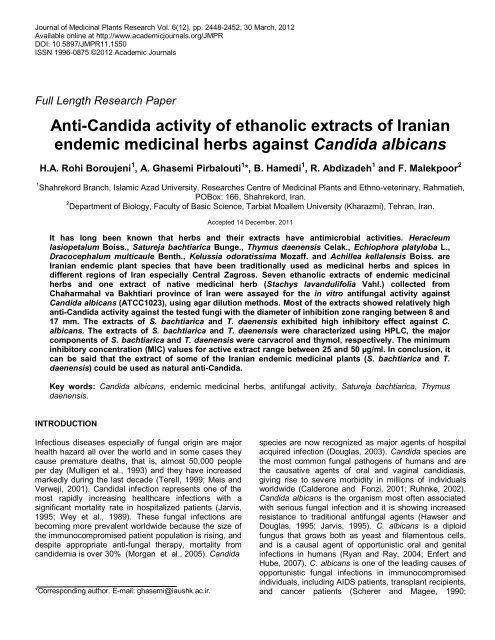Download Complete Issue - Academic Journals
Download Complete Issue - Academic Journals
Download Complete Issue - Academic Journals
You also want an ePaper? Increase the reach of your titles
YUMPU automatically turns print PDFs into web optimized ePapers that Google loves.
Journal of Medicinal Plants Research Vol. 6(12), pp. 2448-2452, 30 March, 2012<br />
Available online at http://www.academicjournals.org/JMPR<br />
DOI: 10.5897/JMPR11.1550<br />
ISSN 1996-0875 ©2012 <strong>Academic</strong> <strong>Journals</strong><br />
Full Length Research Paper<br />
Anti-Candida activity of ethanolic extracts of Iranian<br />
endemic medicinal herbs against Candida albicans<br />
H.A. Rohi Boroujeni 1 , A. Ghasemi Pirbalouti 1 *, B. Hamedi 1 , R. Abdizadeh 1 and F. Malekpoor 2<br />
1 Shahrekord Branch, Islamic Azad University, Researches Centre of Medicinal Plants and Ethno-veterinary, Rahmatieh,<br />
POBox: 166, Shahrekord, Iran.<br />
2 Department of Biology, Faculty of Basic Science, Tarbiat Moallem University (Kharazmi), Tehran, Iran.<br />
Accepted 14 December, 2011<br />
It has long been known that herbs and their extracts have antimicrobial activities. Heracleum<br />
lasiopetalum Boiss., Satureja bachtiarica Bunge., Thymus daenensis Celak., Echiophora platyloba L.,<br />
Dracocephalum multicaule Benth., Kelussia odoratissima Mozaff. and Achillea kellalensis Boiss. are<br />
Iranian endemic plant species that have been traditionally used as medicinal herbs and spices in<br />
different regions of Iran especially Central Zagross. Seven ethanolic extracts of endemic medicinal<br />
herbs and one extract of native medicinal herb (Stachys lavandulifolia Vahl.) collected from<br />
Chaharmahal va Bakhtiari province of Iran were assayed for the in vitro antifungal activity against<br />
Candida albicans (ATCC1023), using agar dilution methods. Most of the extracts showed relatively high<br />
anti-Candida activity against the tested fungi with the diameter of inhibition zone ranging between 8 and<br />
17 mm. The extracts of S. bachtiarica and T. daenensis exhibited high inhibitory effect against C.<br />
albicans. The extracts of S. bachtiarica and T. daenensis were characterized using HPLC, the major<br />
components of S. bachtiarica and T. daenensis were carvacrol and thymol, respectively. The minimum<br />
inhibitory concentration (MIC) values for active extract range between 25 and 50 µg/ml. In conclusion, it<br />
can be said that the extract of some of the Iranian endemic medicinal plants (S. bachtiarica and T.<br />
daenensis) could be used as natural anti-Candida.<br />
Key words: Candida albicans, endemic medicinal herbs, antifungal activity, Satureja bachtiarica, Thymus<br />
daenensis.<br />
INTRODUCTION<br />
Infectious diseases especially of fungal origin are major<br />
health hazard all over the world and in some cases they<br />
cause premature deaths, that is, almost 50,000 people<br />
per day (Mulligen et al., 1993) and they have increased<br />
markedly during the last decade (Terell, 1999; Meis and<br />
Verweji, 2001). Candidal infection represents one of the<br />
most rapidly increasing healthcare infections with a<br />
significant mortality rate in hospitalized patients (Jarvis,<br />
1995; Wey et al., 1989). These fungal infections are<br />
becoming more prevalent worldwide because the size of<br />
the immunocompromised patient population is rising, and<br />
despite appropriate anti-fungal therapy, mortality from<br />
candidemia is over 30% (Morgan et al., 2005). Candida<br />
*Corresponding author. E-mail: ghasemi@iaushk.ac.ir.<br />
species are now recognized as major agents of hospital<br />
acquired infection (Douglas, 2003). Candida species are<br />
the most common fungal pathogens of humans and are<br />
the causative agents of oral and vaginal candidiasis,<br />
giving rise to severe morbidity in millions of individuals<br />
worldwide (Calderone and Fonzi, 2001; Ruhnke, 2002).<br />
Candida albicans is the organism most often associated<br />
with serious fungal infection and it is showing increased<br />
resistance to traditional antifungal agents (Hawser and<br />
Douglas, 1995; Jarvis, 1995). C. albicans is a diploid<br />
fungus that grows both as yeast and filamentous cells,<br />
and is a causal agent of opportunistic oral and genital<br />
infections in humans (Ryan and Ray, 2004; Enfert and<br />
Hube, 2007). C. albicans is one of the leading causes of<br />
opportunistic fungal infections in immunocompromised<br />
individuals, including AIDS patients, transplant recipients,<br />
and cancer patients (Scherer and Magee, 1990;

















